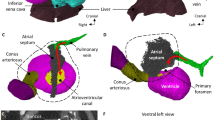Abstract—To substantiate a common mechanism for the flow around the flow channel of the heart left ventricle regardless of the species, the orientation of trabeculae in the left ventricular cavity was anatomically studied in humans and model animals of different sizes, including rats, rabbits, and dogs. Left ventricular cavity casts were used to measure the parameters of the intracardiac trabecular meshwork in humans and animals. Casts of approximately the same size were used in each species to improve the reliability of measurements. Exact solutions of nonstationary hydrodynamics equations for the class of tornado-like swirling flows of viscous fluids were used as a hydrodynamic model to estimate the parameters of the intracardiac blood flow. The degree of twisting was plotted as dependent on the volumetric index of the intracardiac tornado-like jet; the resulting plots showed the continuity of the hyperbolic function for all casts with a high data fitting accuracy (R2 varied from 0.7963 to 0.9081). All points of the dependences therefore corresponded to the convergence condition \({{Z}_{i}}R_{i}^{2}\) = const and might belong to a singular swirling jet and form its boundary layer. Plots of the volumetric change of the jet vs. the longitudinal coordinate were obtained at different angles of cast fixation and were linear in all cases. Given the high fitting accuracy of the data (R2 varied from 0.7882 to 0.8853), the pattern of swirling and the accumulation of the energy of a moving dominant flow were assumed to be similar in humans and animals. The results thus demonstrated that the orientation and coordinated contractions of the trabecular meshwork play a crucial role in the formation of a swirling intracardiac blood flow and agree with general mechanisms of adequate blood flow in humans and animals regardless of the size of the flow channel of the heart.



Similar content being viewed by others
REFERENCES
V. I. Burakovsky, N. B. Dobrova, N. B. Kusmina, et al., Eksp. Khirurg. Anesteziol. 3, 13 (1976).
G. I. Kiknadze and Yu. K. Krasnov, Sov. Phys. Dokl. 10, 799 (1986).
L. H. Back, D. W. Crawford, and R. Barndt, J. Appl. Physiol. 41 (6), 910 (1976).
E. A. Talygin and A. Yu. Gorodkov, Byull. Nats. Tsentra Serdechno-Sosud. Khirurg. 19 (4), 416 (2018).
J. Bremer, Am. J. Anat. 49, 409 (1932).
L. A. Bockeria, G. I. Kiknadze, I. A. Gachechiladze, et al., Cardiometry 3, 5 (2013).
L. A. Bockeria, A. Yu. Gorodkov, G. I. Kiknadze, and M. V. Sokolov, Byull. Nats. Tsentra Serdechno-Sosud. Khirurg. 3 (7), 99 (2002).
E. A. Talygin, N. A. Zazybo, Sh. T. Zhorzholiani, et al., Usp. Fiziol. Nauk 47 (1), 48 (2016).
M. Serrani, M. L. Costantino, and R. Fumero, Comput. Cardiol. 40, 811 (2013).
E. A. Sallin, Biophys. J. 9, 954 (1969).
M. Markl, P. J. Kilner, and T. Ebbers, J. Cardiovasc. Magn. Reson. 13, 7 (2011).
Funding
This work was supported by the Russian Science Foundation (project no. 16-15-00109).
Author information
Authors and Affiliations
Corresponding author
Ethics declarations
Conflict of interests. The authors declare that they have no conflict of interest.
Statement on the welfare of animals. All applicable international, national, and institutional guidelines for the care and use of animals were followed.
Additional information
Translated by T. Tkacheva
Rights and permissions
About this article
Cite this article
Tkhagapsova, M.M., Talygin, E.A., Zhorzholiani, S.T. et al. A Comparative Anatomical Study of the Swirling Flow Parameters in the Left Ventricular Cavity in Animals of Different Sizes Based on the Concept of Tornado-Like Flows of Viscous Fluids. BIOPHYSICS 65, 143–150 (2020). https://doi.org/10.1134/S0006350920010224
Received:
Revised:
Accepted:
Published:
Issue Date:
DOI: https://doi.org/10.1134/S0006350920010224




